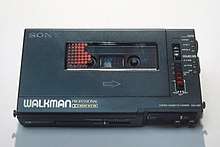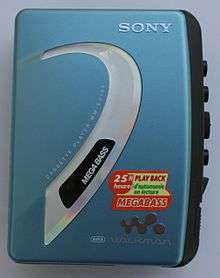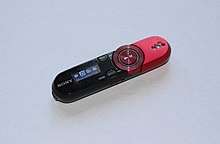Walkman
Walkman is a brand of portable media players manufactured by Sony. The original Walkman, released in 1979, was a portable cassette player that changed listening habits by allowing people to listen to music of their choice on the move.[2][3] It was devised by Sony founders Masaru Ibuka and Akio Morita, who felt Sony's existing portable player was too unwieldy and expensive. A prototype was built from a modified Sony Pressman, a compact tape recorder designed for journalists and released in 1977.[4]
 | |
Original Sony Walkman TPS-L2 from 1979 | |
| Manufacturer | Sony |
|---|---|
| Type | Portable media player |
| Lifespan | July 1, 1979 – October 25, 2010 (Compact Cassette Edition); Approximately 1979 (AM/FM radio); July 1, 1984 – present (all other editions) |
| Units sold | 385 million (as of March 31, 2009)[1] |


The Walkman was followed by a series of international releases; as overseas sales companies objected to the Japanese-English name, it was sold under several names, including Soundabout in the United States, Freestyle in Australia and Sweden, and Stowaway in the UK.[5][6] Eventually, in the early 1980s, Walkman caught on globally and Sony used the name worldwide. "Walkman" became an unofficial term for personal stereos of any producer or brand.[7] Sony continues to use the Walkman brand for most of its portable audio devices, including feature phones.
Sony built round about 200 million Cassette-Walkmans (200,020,000 exactly) worldwide until March 2010.[8]
Development
Compact cassette was developed in 1963 by the Dutch electronics firm Philips. In the late 1960s, the introduction of prerecorded compact cassettes made it possible to listen to music on portable devices as well as on car stereos, though gramophone records remained the most popular format for home listening.[9]
Sony cofounder Masaru Ibuka used Sony's bulky TC-D5 cassette recorder to listen to music while traveling for business. He asked executive deputy president Norio Ohga to design a playback-only stereo version optimized for headphone use.[9] The first prototype was built from a modified Sony Pressman, a mono cassette recorder.[9]
The metal-cased blue-and-silver Walkman TPS-L2, the world's first low-cost personal stereo, went on sale in Japan on July 1, 1979, and was sold for around ¥33,000 (or $150.00).[10] Though Sony predicted it would sell about 5,000 units a month, it sold more than 50,000 in the first two months.[9] Sony introduced the Walkman in the US as the Soundabout and the UK as the Stowaway; as developing new, trademark-free names in every country was expensive, Sony settled on Walkman, a play on Pressman.[9] The TPS-L2 was introduced in the U.S. in June 1980.[9]
The 1980s was the decade of the intensive development of the Walkman lineup. In 1983 Sony introduced the first ultra-compact "cassette-size" Walkman, in 1986 it presented the first model outfitted with remote control. By 1999 Sony sold 186 million cassette Walkmans.[11]
Portable compact disc players caused the decline of different variants of Walkman.[12] The cassette-based Walkman was discontinued in Japan in 2010, but at the time there were no immediate plans to stop production and sales of the device on other markets.[13] The last model available in the U.S. was the WM-FX290W, production of which started in 2004.[14][15][16]
Marketing

(type NWZ-B163FR)
(type NWZ-S765)
The marketing of the Walkman introduced the idea of "Japanese-ness" into global culture, synonymous with miniaturization and high-technology.[17] The "Walk-men" and "Walk-women" in advertisements were created to be the ideal reflections of the subject watching.[18]
A major component of the Walkman advertising campaign was personalization of the device. Prior to the Walkman, the common device for portable music was the portable radio, which could only offer listeners standard music broadcasts.[19] Having the ability to customize a playlist was a new and exciting revolution in music technology. Potential buyers had the opportunity to choose their perfect match in terms of mobile listening technology. The ability to play your own music and listen privately was a huge selling point of the Walkman, especially amongst teens, who greatly contributed to its success.[19] Despite "all this technological diversity, there must be one which is the perfect choice for you".[20] This method of marketing to an extremely expansive user-base while maintaining the idea that the product was made for each individual "[got] the best of all possible worlds—mass marketing and personal differentiation".[20]
Impact
According to Time, the Walkman's "unprecedented combination of portability (it ran on two AA batteries) and privacy (it featured a headphone jack but no external speaker) made it the ideal product for thousands of consumers looking for a compact portable stereo that they could take with them anywhere".[9]
The Walkman had a major influence on 1980s culture.[9] In 1986, the word "Walkman" entered the Oxford English Dictionary.[9] Millions used the Walkman during exercise, coinciding with the start of the aerobics craze.[9] Between 1987 and 1997, the height of the Walkman's popularity, the number of people who said they walked for exercise increased by 30%.[9] Other firms, including Aiwa, Panasonic and Toshiba, produced similar products, and in 1983 cassettes outsold vinyl for the first time.[9]
In German-speaking countries, the use of "walkman" became generic, meaning a personal stereo of any make, to a degree that the Austrian Supreme Court of Justice ruled in 2002 that Sony could not prevent others from using the term "walkman" to describe similar goods. It is therefore an example of what marketing experts call the "genericide" of a brand.[7]
The Walkman had a portable CD player successor, Sony's Discman. In turn, the Walkman and Discman are ancestors of digital audio players (DAP) such as Apple's iPod.[21] Sony's own line of DAPs is known as Network Walkman.[22][23]
Notes
- "Sony Japan - タイムカプセル vol.20 そして、その名は世界共通語になった". Sony.
- Bull, Micheal (2006). "Investigating the Culture of Mobile Listening: From Walkman to Ipod". Consuming Music Together.
- Du Gay, Paul (1997). Doing Cultural Studies: The Story of the Sony Walkman. SAGE Publications. ISBN 9780761954026.
- "BBC World Service - The History Hour". BBC. Retrieved 2019-07-12.
- "Läsarnas sjuka varumärken". Dn.se. Retrieved 2011-01-14.
- Matt Novak (1 July 2014). "The Sony Walkman was introduced in the U.S. as the Soundabout". Gizmodo.
- Mark Batey (2016), Brand Meaning: Meaning, Myth and Mystique in Today’s Brands (Second ed.), Routledge, p. 140
- walkman-archive.com, Gallery Sony, retrieved 31 May 2020.
- Haire, Meaghan (2009-07-01). "The Walkman". Time. ISSN 0040-781X. Retrieved 2018-08-20.
- Carl, Franzen (July 1, 2014). "The History of the Walkman: 35 Years of Iconic Music Listening". The Verge.
- "Sony Celebrates Walkman(R) 20th Anniversary". www.sony.net. 1999-07-01.
- Lauren Indvik, Mashable. "Sony retires the cassette Walkman after 30 years". CNN. Retrieved 2011-01-14.
- "Sony Retiring Cassette Walkman in Japan". ABC News. 2010-10-25. Retrieved 2011-01-14.
- Chan, Casey. "Sony Kills The Cassette Walkman On The iPod's Birthday*". Gizmodo. Gawker.
- "Walkman digital tuning weather radio/cassette player WM-FX290W". www.sonystyle.com. Archived from the original on 2009-01-05.
- Vis, Peter. "Sony WM-FX290 repair and service". www.petervis.com.
- Du Gay
- Du Gay, 25
- Weber, Heike (2009). "Taking Your Favourite Sound Along: Portable Audio Technologies for Mobile Music Listening". Sound Souvenires. Amsterdam University Press.
- Du Gay, 31
- Southerton, Dale (2011). Encyclopedia of Consumer Culture. SAGE Publishing. p. 515. ISBN 9780872896017.
- "Sony's modern take on the iconic Walkman". The Hindu BusinessLine. Retrieved 2020-05-17.
- "Sony History". Sony Electronics Inc. Retrieved 2020-05-17.
References
- Du Gay, Paul; et al. (1997). Doing Cultural Studies: The Story of the Sony Walkman. London: SAGE Publications, in association with The Open University. ISBN 0-7619-5401-5. OCLC 651974258.
